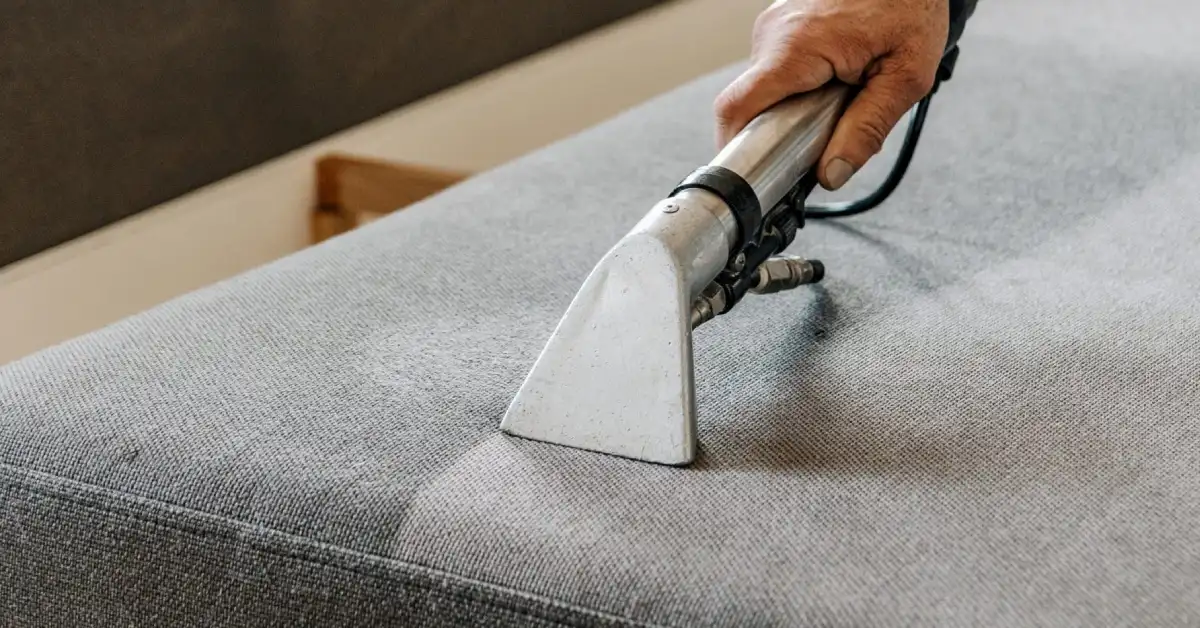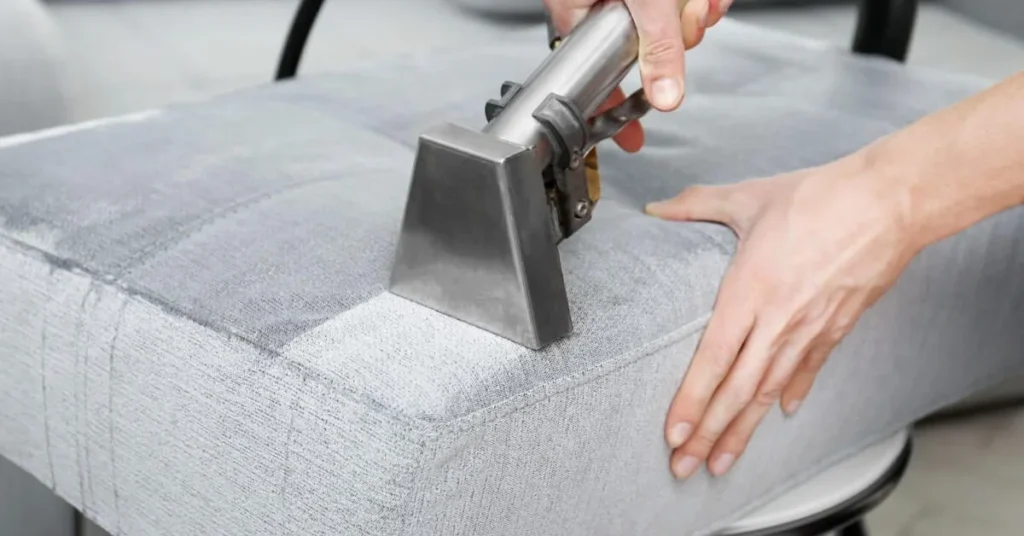Your couch holds about 12 times more bacteria than a toilet seat—surprising, right? Professional cleaning can make your furniture look and feel new again. Most people are. But there’s good news: Professional upholstery cleaning can restore your furniture to its fresh, clean state.
Why Professional Cleaning Service Matters!
Your furniture takes a beating daily. Pet hair, food spills, and invisible dust settle into every fiber, making your furniture look dull and potentially impacting your health.
Professional cleaners use methods that reach deep into fabric fibers, removing dirt and particles that regular vacuuming misses. This keeps furniture looking newer and extends its lifespan.
Cleaning also improves your health. Upholstery furniture traps allergens like dust mites and pet dander, which can worsen allergies. Professional services remove these irritants, making your home safer for sensitive individuals.
Those microscopic dust mites that feed on dead skin cells love upholstery. A thorough upholstery cleaning dramatically reduces their population, improving air quality throughout your home.
Regular professional cleaning also extends furniture life. It prevents dirt buildup that wears down fabric fibers over time, helping your expensive sofa or favorite armchair look better and last years longer.
Then there’s stain removal. Those spots you’ve tried but failed to clean yourself? Professionals have specialized solutions for different stains and fabrics. Whether it’s red wine, pet accidents, or mystery marks, they can often restore fabric to its original condition.
How to Choose the Right Cleaning Service?
Finding a reliable cleaning service takes some homework. Here’s what matters when making your choice:
How to Choose a Cleaner
When choosing an upholstery cleaning service, look for these qualifications:
- IICRC Certification – Gold standard for proper techniques across fabric types.
- CRI Seal of Approval – Proven effective cleaning equipment/products.
- Green Seal Certification – Eco-friendly solutions safe for homes.
- Woolsafe Certification – Critical if you have wool upholstery, as these professionals specialize in cleaning wool fabrics without causing damage.
- Better Business Bureau Accreditation – While not specific to cleaning skills, BBB accreditation indicates good business practices and proper customer issue resolution.
- Local Business Licenses – Always check that any service you hire has proper business licensing for your area, confirming they’re legitimate.
Customer reviews reveal a lot about quality. Check ratings on Google Business Profile, Yelp, or company websites, focusing on reviews specifically mentioning upholstery cleaning, not just general cleaning services.
Ask about specializations. Some companies excel with certain materials like leather or delicate fabrics. Others offer additional services, such as curtain cleaning or mattress sanitizing. Confirm they can handle your specific furniture types.
Experience counts in this business. Companies with years of service have encountered virtually every stain and fabric type. They’ll know which techniques work best for your furniture.
Ask about cleaning methods and products. Eco-friendly solutions protect your home, family, and environment. This is especially important for households with chemical sensitivities.
Get a detailed quote that accounts for furniture size, fabric type, soil level, and special treatments. Be suspicious of quotes that seem too low – quality cleaning requires proper time and materials.
Finally, ask about drying times. Some companies use quick-drying methods that let you use your furniture within hours, while others might need 24-48 hours of drying time – important information when planning your cleaning schedule.
Cleaning Techniques: What to Expect?
Professional cleaners use different methods based on your furniture’s fabric and condition.
Steam cleaning uses hot water and suction to clean fabrics deeply. It’s ideal for most materials and removes dirt and allergens effectively. This method effectively deep cleans and removes allergens from most fabrics.
Dry cleaning uses specialized solvents needing minimal moisture. This works well for delicate fabrics that might shrink or become damaged with too much water. The solution dissolves dirt and stains without soaking the furniture.
Foam cleaning applies a foaming cleaner to the upholstery, agitates it to loosen dirt, and then removes it. Using less moisture than steam cleaning but more than dry cleaning makes it ideal for moderately delicate fabrics.
Leather furniture requires specific cleaners and conditioners that clean without drying out the leather, maintaining its suppleness and appearance.
Spot treatment targets specific stained areas without cleaning the entire piece. Professionals assess the stain type and fabric to select the right remover, using specialized tools to work the solution into the stain without damaging surrounding areas.
The typical cleaning process begins with a thorough inspection. Technicians identify fabric type, examine stains, and note special concerns. Next, they vacuum to remove loose dirt before applying their chosen cleaning method.
After the main cleaning, they may use spot treatments for stubborn stains, then groom the fabric to restore its texture and appearance. Finally, they’ll set up fans or other equipment to speed drying if needed.
Maintenance Tips for Upholstery Longevity
Between professional cleanings, these simple maintenance steps keep your furniture looking great:
- Weekly Vacuuming – Use an upholstery attachment to remove surface dirt before it settles deep into the fibers. Vacuum in multiple directions for better particle extraction.
- Immediate Spill Response – Blot (never rub) spills right away with a clean, white cloth. Work from the spill’s edge inward to prevent spreading.
- Rotate Cushions Monthly – Rotate cushions monthly to prevent uneven wear and fading.
- Use Arm Covers – Place washable covers on armrests where hand and arm oils frequently contact with fabric. These inexpensive protectors are easily laundered.
- Control Sun Exposure – Position furniture away from direct sunlight or use window treatments to filter UV rays that fade and weaken fabrics.
- Apply Fabric Protectors – Consider stain-resistant treatments after professional cleanings to repel liquids and prevent stain setting.
- Clean According to Fabric Type – Follow manufacturer recommendations for your specific upholstery. What works for cotton might damage silk or velvet.
- Avoid Eating on Upholstered Furniture – If possible, establish a “no food” rule for sofas and chairs to prevent food stains and crumbs.
- Keep Pets Off Furniture – Train pets to stay off furniture or use pet-specific furniture covers that remove easily for washing.
- Quarterly Spot Cleaning – Address minor stains with appropriate cleaners before they become permanent. Always test cleaners on an inconspicuous area first.
- Brush Natural Fibers – For fabrics like wool or cotton, gentle brushing with a soft-bristled brush maintains texture and removes surface debris.
- Maintain Indoor Humidity – Keep home humidity between 40-60% to prevent fabric fibers from becoming brittle and breaking down prematurely.
Cleaning Service Costs and Frequency
Professional upholstery cleaning costs vary based on several factors that affect your budget.
Furniture size significantly impacts pricing. Cleaning a loveseat costs less than a sectional sofa simply because there’s less fabric to clean. Most services charge by the piece or by seat cushion.
Fabric type influences price, too. Delicate or specialty fabrics like silk, wool, or velvet require special handling and products, typically costing more than cleaning standard cotton or polyester blends.
Stain severity affects the final price. Heavily soiled furniture or stubborn stains may require additional treatments, increasing the overall cost.
Location matters as well. Services in major cities or affluent areas often charge more than those in smaller towns. In 2024, expect to pay $100-$200 for cleaning a standard three-seat sofa, depending on these factors.
Most households need cleaning every 1-2 years. If you have pets, aim for every 6-12 months to address hair and accidents:
- Households with young children typically need cleaning every 6-12 months because of spills and stains.
- People with allergies or asthma should schedule cleaning every 6-8 months to remove allergens.
- High-traffic homes where furniture gets heavy use may need cleaning every 8-12 months.
Many homeowners opt for seasonal cleaning, scheduling service in spring to remove winter’s accumulated indoor pollutants, or in fall before spending more time indoors during winter.
Between upholstery care, regular vacuuming and prompt stain treatment will maintain your furniture’s appearance and extend professional cleaning benefits.
Benefits of Eco-Friendly Upholstery Cleaning

Green cleaning solutions have surged in popularity for good reasons. Eco-friendly upholstery cleaning offers distinct advantages over traditional methods.
Health benefits top the list. Green cleaning products contain fewer harsh chemicals, leaving minimal residue that might cause skin irritation or breathing problems. This matters especially for households with children, pets, or people with chemical sensitivities.
Environmental benefits are equally important. Eco-friendly solutions break down naturally without releasing harmful compounds into water systems and typically use less water, conserving this resource.
Many green cleaning services use plant-based solutions from renewable sources like citrus, coconut, or corn. These natural ingredients work just as effectively as chemical cleaners for most common stains and dirt.
Companies offering eco-friendly services often extend their environmental commitment throughout their operation, using energy-efficient equipment, minimizing water waste, and reducing plastic packaging.
The cleaning process itself tends to be gentler on fabrics while still providing deep cleaning. This helps preserve colors and textures over time, potentially extending the furniture’s lifespan.
When selecting an eco-friendly service, ask about specific green practices and product ingredients. Truly eco-friendly companies willingly share their methods and materials.
Making the Most of Your Cleaning Service
To get optimal results from professional cleaning, prepare properly:
Clear small items, decorative objects, and loose cushions before technicians arrive. This gives them full access to all furniture areas without disturbing your belongings.
Show them specific stains or problem areas when they arrive so they can focus special attention on your main concerns.
Ask for care recommendations between professional visits. Technicians can provide specific advice for your particular furniture types and fabrics.
Consider scheduling upholstery cleaning alongside carpet cleaning for a complete home refresh. Many companies offer package discounts.
After cleaning, follow the drying time instructions carefully. Using furniture before it’s completely dry can create new stains, mildew, or fabric damage.
Keep pets and children away from freshly cleaned furniture until fully dry to prevent immediate resoiling.
Take before and after photos of severely stained items to appreciate the results and provide documentation if you’re not completely satisfied.
Conclusion
Professional upholstery cleaning creates a healthier home by removing allergens and bacteria that regular cleaning misses. With proper care between services, your furniture stays beautiful and functional for years.
When choosing a service, look for proper certification, positive reviews, and clear pricing. Ask about cleaning methods and consider eco-friendly options for a healthier home and planet.
Regular cleaning combined with good maintenance habits means cleaner, fresher furniture that lasts longer and contributes to better indoor air quality. The investment pays off not just in furniture longevity but in creating a more comfortable, healthier living space for your family.


